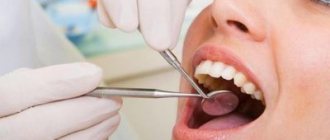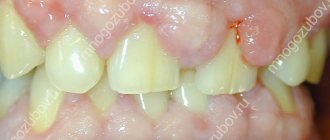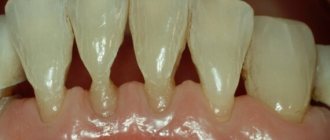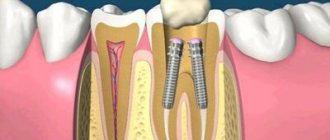What is an abscess
People who do not pay attention to oral hygiene and proper gum care will sooner or later find out what a tooth abscess is. This is an acute inflammatory dental disease, which is often a complication of other pathologies.
There is an accumulation of pus under the tooth in the gum or hole left after extraction. A dense rounded bulge is formed. This is a fistula - a channel through which pus comes out of the tooth. Sometimes it opens and the contents leak out. But this does not mean that the pathology has passed, because its cause has not been eliminated. If bacteria continue to multiply, pus will again accumulate in the dental canal.
Without timely treatment, it is dangerous to health. An extensive abscess of the jaw may appear, the infection will penetrate into the bone or spread through the blood throughout the body. This threatens the development of osteomyelitis, inflammation of the bone marrow, and sepsis.
Classification of abscess in dentistry
Doctors say there are three types of tooth abscess:
- Desnev. Only the soft tissues of the mouth are damaged. But, if the disease is started, the periodontal ligaments and periosteum will be drawn into the inflammatory process. Then flux develops.
- Periapical. The pulp is affected. If treatment is not carried out in a timely manner, you will have to perform depulpation or, even worse, tear out the affected unit. More often, this type of disease is diagnosed in children with primary occlusion, which is why dentists have to remove a preschooler’s incisors, canines and molars without waiting for their natural replacement by molars.
- Periodontal. The abscess has a destructive effect on the root, so the tooth becomes loose and falls out prematurely.
The main danger of a purulent tooth abscess is that the pus that has accumulated inside the tumor can penetrate into the blood. Then a general intoxication of the human body will occur. Internal organs, bones, and brain come under attack. A person who ignores the presence of an abscess may develop meningitis, sepsis, and even die.
Types and forms of abscess
Depending on where the pus accumulates, there are three types of pathology:
- gum abscess or gumboil affects only the gums;
- periodontal develops in the periodontal pocket;
- periapical appears with severe destruction of the pulp and other dental tissues.
This pathology often occurs in an acute form and requires immediate dental treatment. But sometimes the fistula opens on its own. The pus comes out and the patient feels relief. If complex therapy is not carried out, the pathology can become chronic.
What is dental granuloma, the reasons for the formation
Dental granuloma is a pathological neoplasm of periodontal tissues affected by inflammation, appearing in the upper part of the tooth root. Externally, the granuloma looks like a dense small nodule (up to 0.5 cm in diameter). If you do not urgently treat a dental granuloma, it will continue to develop and deform into a radicular cyst - a capsule that is filled not only with dead tissue cells, but also with pus and bacteria.
Some people believe that a cyst and a dental granuloma are the same thing. But these are different diseases. The tooth cyst is larger in size and does not show any symptoms longer. As granuloma develops, the tooth will become very painful.
What causes dental granuloma? There are a number of reasons that contribute to the occurrence of pathological formation at the apex of the tooth root:
1. Granuloma under the tooth can occur as a complication of caries, pulpitis, periodontitis, the treatment of which was not carried out on time. It is important to understand that no dental disease goes away on its own! If you don’t treat your teeth, they will continue to decay, and the inflammatory process will spread to the internal tissues of the tooth and to its root!
2. Poor quality of dental treatment can lead to the appearance of a granuloma on the root of a tooth. If mistakes were made during the treatment of caries or other dental diseases, for example, the tooth canals were poorly cleaned and treated, then in the future there is a high risk of various complications, including the formation of granulomas on the root of the tooth.
3. Severe tooth trauma, leading to infection penetration to the root.
These are the main reasons that can provoke the growth and development of granulomas on the roots of the tooth. If you do not want to face such an unpleasant disease, never delay dental treatment, which you can undergo without pain and stress in our dental clinic in Moscow - Firadent.
It is worth learning and remembering that granuloma can appear after tooth extraction. Most often this happens when the tooth was removed incorrectly or after the operation the patient did not follow the doctor’s recommendations on hygiene. Bacteria easily enter the open socket that remains after the tooth is extracted from the gums, and as a result of their active reproduction, an inflammatory process begins and a granuloma is formed.
Symptoms
The main symptom of a tooth abscess is pain. It is localized in one place and intensifies when pressed or chewed. The tooth becomes sensitive to cold, hot or sour foods. If the tumor appears in the upper jaw, pain spreads along the trigeminal nerve.
The following manifestations of pathology are also common:
- malaise, weakness, headache;
- temperature increase;
- swelling and redness of the gums;
- swollen lymph nodes;
- the appearance of greenish discharge;
- the face becomes asymmetrical;
- if there is pus in the mouth, an unpleasant odor and bitter taste appear.
Why does pain occur?
Caries first attacks the hardest tooth tissue, the enamel. Then the dentin underneath begins to deteriorate. When the carious cavity reaches a large size, the infection will reach the pulp, ending in the root canals. An infected pulp causes increased blood flow, pressure in it increases and, not finding a way out, leads to painful sensations. Thus, the need arises for the treatment of pulpitis or periodontitis .
The pulp can become infected for other reasons:
- due to mechanical damage resulting from an impact;
- with impaired blood circulation in the jaw area;
- with neuralgia of various origins;
- due to infection spreading from periodontal pockets in patients with periodontal disease and periodontitis.
Causes of abscess
The main cause of tooth abscess is the penetration of bacteria. This can happen if hygiene rules are not followed, enamel or gums are injured. Pus often accumulates in the tooth in the presence of large carious cavities, pulpitis, gingivitis, and periodontitis.
Sometimes a tooth abscess develops after it is removed. The reason may be failure to follow the extraction technique or the use of poorly sterilized instruments. If removal is difficult, a fragment or piece of root may remain in the hole. But even if the dentist did everything correctly, a gum abscess may develop if the doctor’s recommendations are not followed.
Less commonly, the cause is common infectious diseases. It could be otitis media, sinusitis, pneumonia. The infection is carried into the gums through the bloodstream. At risk are people who eat a lot of sweets, people with diabetes, and people with reduced immunity.
Treatment of acute periodontitis and exacerbation of chronic
These forms of the disease are characterized by concomitant severe inflammation in the gums and the development of suppuration. The patient is in pain. If the situation is ignored, it sometimes leads to swelling of the soft tissues of the face and a rise in temperature.
Such symptoms should be treated urgently. When a person goes to the hospital, the doctor identifies an exacerbation of chronic or diagnoses acute periodontitis and performs an autopsy of the tooth. This way, the pus leaves the root canals, and the patient feels better.
If the abscess has spread further into the tissues of the mouth, even into the cheeks, the dentist will cut the gum.
After the operation, fillings are not placed and the treatment steps described above are not applied. The patient lives for several days with an open tooth or accessible canals to ensure the outflow of pathological contents. While eating, the tooth is closed with a cotton ball, then opens again. The main thing for the patient is to prevent pieces of food from getting into uncovered cavities, avoiding re-inflammation.
In a paid clinic, the mentioned procedures are performed at the patient’s expense; the cost depends on the rating of the institution and the category of the doctor. Usually - in the range of 2000-2500 rubles.
When visiting a hospital at the place of residence with an insurance policy and passport, the patient has the right to count on free medical care.
Treatment methods
Pathology sometimes does not cause pain at the initial stage, so not everyone goes to the doctor on time. But usually the inflammatory process develops quickly, and within a day a noticeable tumor forms. You definitely need to see a dentist. Only a doctor after an examination can determine how to treat a tooth abscess.
Home remedies such as rinsing the mouth with saline solution or herbal decoctions, as well as taking painkillers, may provide temporary relief, but will not eliminate the cause of the pathology. They can be used if it is not possible to immediately get to the dentist.
Treatment prescribed by a doctor must be comprehensive. Its purpose is to remove pus and destroy infection. The following methods can be used for this:
- drainage of pus;
- cleaning dental canals or sockets after extraction;
- treatment of caries, pulpitis and filling;
- use of local antiseptic and anti-inflammatory drugs;
- taking antibiotics, anti-inflammatory and painkillers.
Opening a tooth abscess is often performed surgically. Some clinics use low-intensity laser. It allows you to painlessly clean the cavity from pus and disinfect it.
If inflammation has developed on a healthy tooth, it can be saved if you consult a doctor in a timely manner. Removal is a last resort; doctors resort to it only in advanced cases. But this is the main method of treatment if an abscess has developed in a baby tooth or wisdom tooth in an adult, as well as in cases where the dental tissue is severely destroyed.
How to treat a tooth abscess
Treatment of a tooth abscess is aimed at eliminating the infectious process and relieving pain. A comprehensive program may include the following activities:
- Opening and draining the lesion. An incision is made on the gum, a drainage is installed through which the pus can freely come out. The drainage system is installed for several days. During this period, the patient is prescribed rinses with antiseptics and saline solutions.
- Endodontic treatment. It involves removing the pulp, treating the root canals with medications and filling them.
- Excision of the root apex. Surgical intervention is performed when the source of infection is located in the periapical area. The surgeon cuts the gum and removes the abscess along with the affected part of the root. The segment itself is preserved.
- Removing a unit. The need for tooth extraction occurs when there is significant destruction of the tooth.
- Therapy with broad-spectrum antibiotics.
- Restoration of the coronal part with a filling or orthopedic construction.
Disease prevention
The occurrence of such inflammation can be prevented.
To do this, you need to follow preventive measures:
- brush your teeth thoroughly twice a day using not only a brush, but also dental floss;
- change the brush to a new one every 2-3 months;
- eat a balanced diet, limit your consumption of sweets;
- take multivitamins;
- visit the dentist annually for a preventive examination;
- carry out dental treatment in a timely manner and remove tartar.
An abscess is a serious pathology that, without treatment, can lead to dangerous consequences. To avoid this, you should immediately contact your dentist if you experience any problems or discomfort. Simple rules of prevention will help maintain health.
The dangers of treating periodontitis at home
The desire of some people to avoid visiting the dental office by any means and continue to endure pain cannot be explained. At the same time, patients persistently practice self-medication, search for recipes on the Internet, rinse their mouths with herbs and smear their sore teeth with homemade compounds of dubious content.
Unfortunately, none of the diseases mentioned in the article can be treated at home. Any method that has been proven over the years, which refers to grandmother’s recipes, will not heal, but will only ease the pain and help the outflow of purulent contents. Remember, the use of this or that non-traditional method of treatment must obtain the approval of a doctor.
Painkillers are also only allowed in limited quantities. Many drugs have a strong and negative effect on the liver and gastrointestinal tract. Therefore, it is unacceptable to constantly relieve pain with pills. And heating a sore tooth, trying to reduce the level of discomfort, is strictly prohibited!
Taking self-prescribed antibiotics will not be successful, because the drug is not able to penetrate into the root canals. It will also not be possible to disinfect and eliminate the source of inflammation by rinsing your mouth. In addition to the warnings voiced, let us remind you that the pathogenic microflora of carious tissues is extremely resistant to drugs, so it cannot be destroyed by taking drugs; drilling is required.
It is better to direct all unspent energy to the prevention of dental diseases. Choosing the right toothbrush, getting into the habit of flossing, and getting regular professional teeth cleanings at your doctor's office are the foundations of oral health.
Treatment of pericoronitis of the wisdom tooth in the lower jaw
Retreatment of tooth canals before prosthetics, with granuloma, cyst and aching pain
Dental treatment without a drill, placing a filling without drilling in Moscow
Treatment of tooth enamel erosion, causes, photos, price
Repeated endodontic treatment of tooth canals for pulp inflammation
Restoration of tooth enamel, price, drugs
Treat or remove wisdom tooth pulpitis
Price for dental treatment in Kazan
| Service | Price |
| Treatment of superficial and medium caries | 2500 rub. |
| Treatment of deep caries | 2800 rub. |
| Treatment of pulpitis of a single-rooted tooth | 2300 rub. |
| Treatment of pulpitis of a two-root tooth | 3300 rub. |
| Treatment of pulpitis of a three-root tooth | 4300 rub. |
| Treatment of periodontitis of a single-rooted tooth in one visit | 2600 rub. |
| Treatment of periodontitis of a two-root tooth in one visit | 3600 rub. |
| Treatment of periodontitis of a three-root tooth in one visit | 4600 rub. |
Relieve pain before going to the doctor
For any form of periodontitis, it is necessary to make an appointment with a doctor, but often the aching tooth “does not want” to wait for the appointed time and hurts unbearably. Taking a pain reliever will help relieve the condition. For toothache, experts advise taking medications that are most optimal for such cases. The pill will not cure, but it will relieve the pain. This does not mean that you can postpone a visit to the doctor - after the pill wears off, the pain will return, so a trip to the dentist should not be postponed or put off “for later”.











